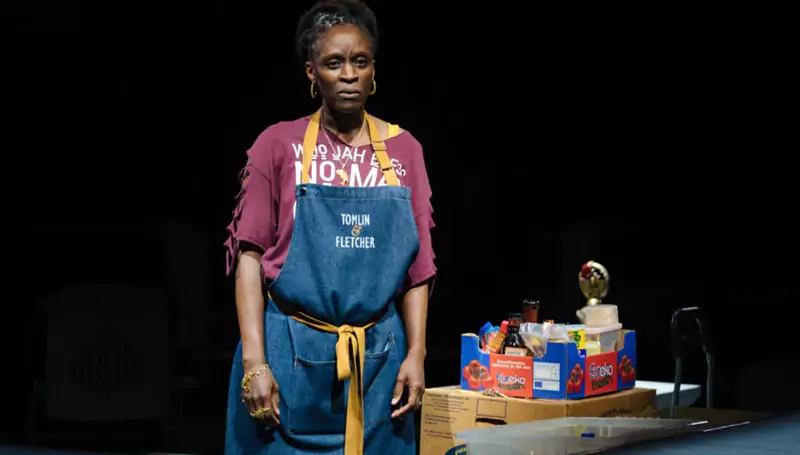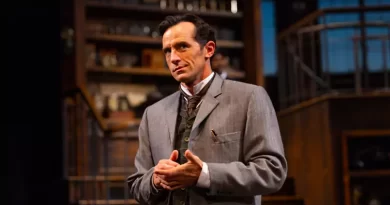“Death of England: Closing Time” at @sohoplace
Jeremy Malies in the West End
3 September 2024
Peter Hall used to say that good politics always makes bad art. The third in the Death of England interlinked trilogy of plays is unwieldy because, however admirable the arguments might be, the pleas for equality across gender and race seem to have been crammed into the dialogue. Only rarely do they emanate naturally from Denise (played by Sharon Duncan-Brewster) and Carly (played by Erin Doherty).
Even the core logistics of the play seem stretched. Denise is baking Jamaican patties in one part of a small retail space in Leyton while Carly is selling flowers from another! That’s a toxic combination that might get up the noses of punters in the wrong way. Have joint writers Roy Williams and Clint Dyer (Dyer also directs) thought this through?
You would leave underwhelmed if you saw this on its own (each play is supposed to work on a standalone basis) without first seeing Death of England: Michael and Death of England: Delroy which are superior.
Said retail space uses the same design as before by Sadeysa Greenaway-Bailey and ULTZ though now the cruciform is only occasionally lit up as the Cross of St George and is more a set of recesses from which the women throw salvoes at each other and store their tatty shop stock. Although Carly is not actually married to offstage Delroy, the two women are essentially daughter-in-law and mother-in-law. I should have liked more subtle analysis of what Denise as a Jamaican thinks of her son being the long-term partner of a woman whose father was known to be racist. The pair are about to hand over the keys to a bailiff acting for the new tenant who will be running a branch of the Gail’s bakery and café chain. (The company has recently, for real, introduced London to the concept of the £5 loaf.)
So what has caused the business to fail apart from incompatibility of the two offerings? The dual shop is being boycotted by the community (TikTok has spilt over into the high street) after Carly, tanked up during a hen night, has made clumsy statements about mixed-race couples based on her experience which she sees as an elimination of wokeness and a kind of social realpolitik. The speech and a subsequent unwise explainer-justification (“I’ll just wait for more people to come on …”) will surely become audition pieces for future actors. Doherty’s energy and powers of mimicry here (she even imitates Thomas Coombes and Paapa Essiedu from the other shows) are staggering.
But I felt I was being preached to when, for no good reason that I could fathom, Jackie Shemesh’s lighting began to pick out Union Jacks emblazoned with photographs of notable female black role models. This is a latter-day equivalent of Bernard Shaw at his worst, with characters little more than mouthpieces for social points particularly about cancel culture. Most of this limitation in the script must be dealt with by Doherty whose formidable technique just about allows her to keep the role three-dimensional.
Duncan-Brewster has more naturalistic lines and I absolutely felt for her character as the social media fallout denies her career advancement as a chef. She is similarly affecting when she describes the horror of seeing son Delroy “become a nodding dog around Carly”. She is given resonant things to say about virtue-signalling white privilege. And yet the cultural references fall flat. Would one woman really accuse the other of a lack of realism on account of being “too busy playing Educating Rita”?
Even the socio-economic theme of gentrification could be dealt with more skilfully. I found it distracting that Kamala Harris’s six-week-old campaign should be dropped into the text. If it’s a state-of-the-nation play I should like to understand what is happening around these women on the streets of Leyton and this can then lead me to parallels.
In a few ways the play improves on the two pieces that have gone before. (I speak about the sequence in which they have been shown to critics, but they can be watched in any order.) Doherty’s slick interaction with the audience outstrips anything from Essiedu who seemed to get bogged down in this on press night. I doubt if the lady in the stalls who was invited to share Carly’s cocaine (she declined) has quite got over it.
And I liked the apposite music choices, notably Brian Ferry’s “Slave to Love” as Carly speaks about the Shakespearean theme of falling in love instantaneously. She also references Ophelia’s mad scene (unconsciously perhaps) with the faded flowers around her reinforcing this idea.
The structure is clunky. Apart from the brief hen-night scene when I suppose we might be one of the party, there is no structural premise for addressing the audience so often. In the other plays there are reasons for it such as a funeral and a boxing match. And I was simply irritated by the dummy mobile phones on a rail in front of us. (I nearly sent one spinning out of the circle into the stalls.) I get it that TikTok is omnipresent. And I can imagine this without something so literal. I felt patronized.
Dyer and Williams are more assured when they criticize the royal family in a scene where the women remember watching King Charles’s coronation. For them it’s a display by waxwork figures. There are good gags about Delroy and Carly’s daughter being christened Meghan. Only researching Doherty later did I realize that she played the young Princess Anne in Netflix’s The Crown which has a neatness to it.
A white woman saying she is bored of wokery while in a relationship with a black man is a strong central idea. And it is of course outrageous that we should all live in fear of getting a pronoun wrong. But this is a flawed play. Unlike Carly’s misguided social media rant, it ain’t going to go viral.









